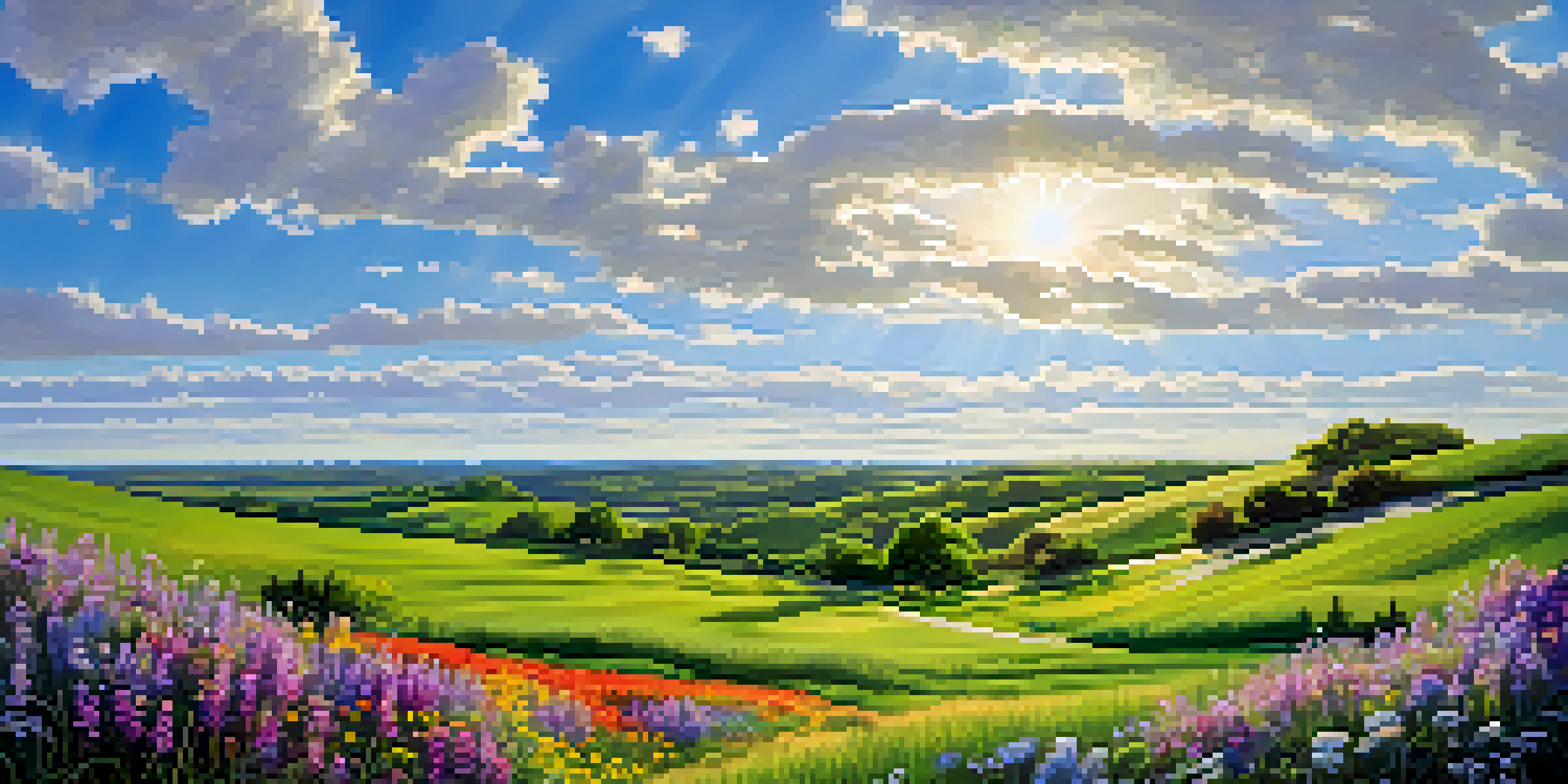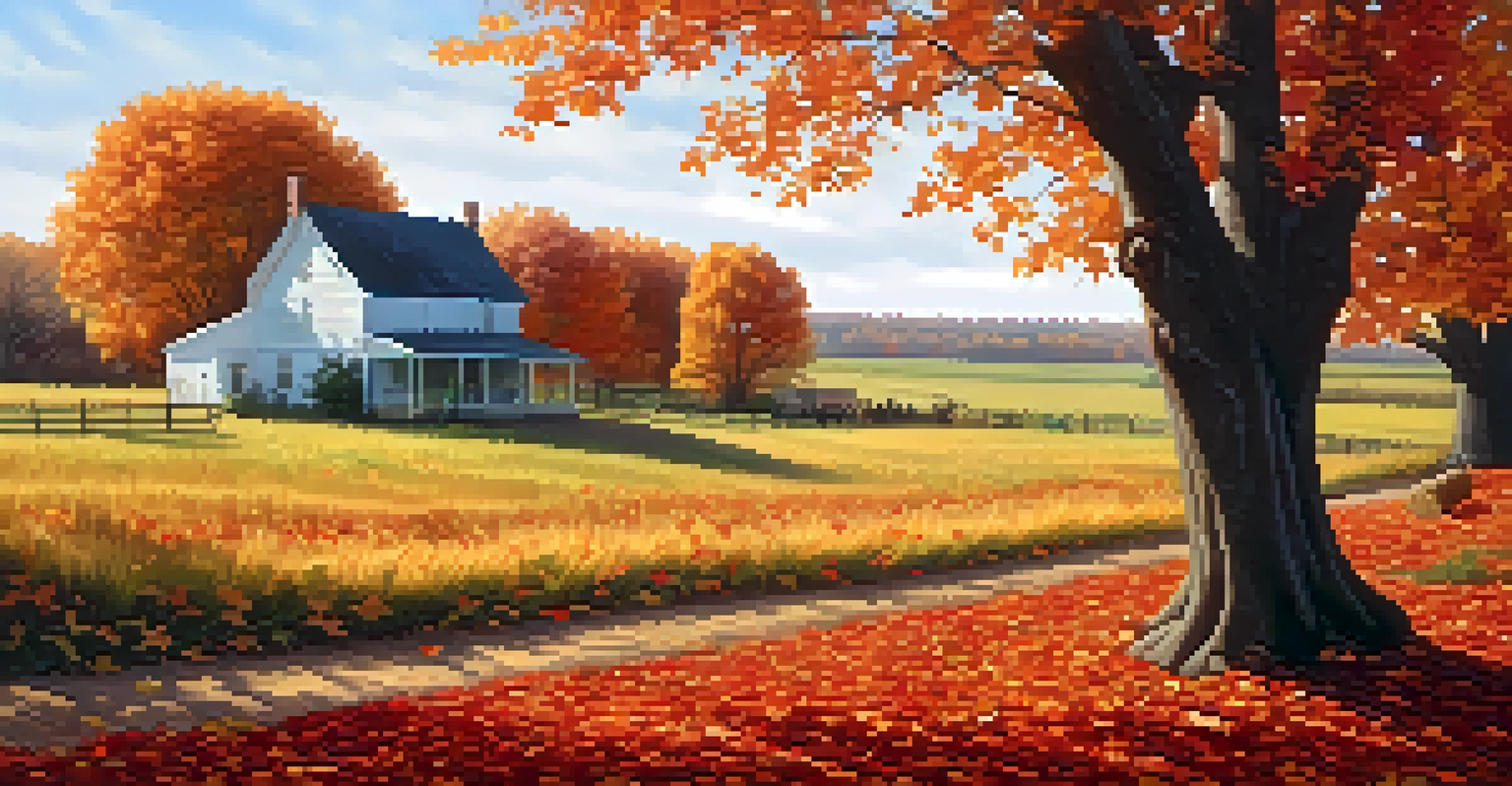Understanding Kansas Climate: Patterns and Seasonal Variations

Overview of Kansas Climate: A Diverse Landscape
Kansas is known for its diverse climate, which is influenced by its geographic position in the central United States. This means that the state experiences a mix of weather patterns, from humid subtropical in the east to semi-arid in the west. Understanding this variation is crucial for residents and visitors alike, as it shapes everything from agriculture to outdoor activities.
The weather is a great metaphor for life – sometimes it's good, sometimes it's bad, and there's nothing much you can do about it but carry an umbrella.
As you travel across Kansas, you might notice differences in temperature and precipitation, which can be attributed to elevation and proximity to large bodies of water. For example, the eastern part of the state often enjoys milder winters compared to the harsher conditions found in the western regions. This climatic diversity creates unique ecosystems and influences the lifestyle of the locals.
Overall, the climate of Kansas is not just a backdrop; it plays a fundamental role in shaping the culture, economy, and daily life of its residents. Appreciating these climate variations can deepen your understanding of what makes Kansas truly unique.
Spring in Kansas: A Time of Renewal and Storms
Spring in Kansas is often marked by a beautiful transformation as nature awakens after winter. From March to May, you can expect temperatures to rise, with average highs ranging from the upper 50s to the mid-70s Fahrenheit. This season brings vibrant wildflowers and a burst of greenery, making it a delightful time for outdoor enthusiasts.

However, spring also comes with its share of challenges, particularly severe thunderstorms and tornadoes. The clash of warm, moist air from the south with cooler air from the north can lead to volatile weather patterns. Residents are advised to stay informed about weather alerts, as spring storms can be intense and unpredictable.
Kansas Climate: A Diverse Landscape
Kansas experiences a wide range of climates, from humid subtropical in the east to semi-arid in the west, impacting agriculture and daily life.
Despite these challenges, spring is a celebrated season in Kansas, with numerous festivals and events that highlight the beauty of the landscape. From blooming gardens to local fairs, there's an undeniable energy in the air that makes this time of year special for many Kansans.
Summer Heat: Embracing the Sunshine and Humidity
Summer in Kansas, lasting from June to August, brings hot temperatures and high humidity, especially in the eastern region. Average highs can soar into the 90s Fahrenheit, making it essential for locals to find ways to stay cool. Ice-cold lemonade and swimming pools become staples during this sweltering season.
In the spring, I have counted 136 different kinds of weather inside of 24 hours.
Alongside the heat, summer often features afternoon thunderstorms that can provide welcome relief from the rising temperatures. These storms, while sometimes severe, help maintain the lush greenery that many Kansans cherish. The combination of heat and rain creates an idyllic setting for crops, which is vital for the state’s agricultural economy.
Summer also presents an opportunity to enjoy various outdoor activities, from hiking to camping. Kansas is home to beautiful parks and lakes, making it the perfect setting for family outings and adventures in nature. Just remember to hydrate and seek shade whenever possible!
Fall Foliage: A Spectacular Display of Colors
Fall in Kansas, spanning from September to November, is a visual feast as leaves change from green to vibrant hues of red, orange, and yellow. As temperatures gradually drop, average highs range from the upper 70s in September to the 50s by late November. This seasonal shift invites many to explore the scenic beauty of the state's landscapes.
Harvest time also takes center stage in the fall, particularly for farmers who grow crops like corn and soybeans. Local festivals celebrating the harvest are common, showcasing the community's connection to the land. These events offer delicious food, lively activities, and a chance to appreciate the hard work that goes into agriculture.
Seasonal Changes and Activities
Each season in Kansas offers unique experiences, from spring storms and summer heat to beautiful fall foliage and winter sports.
Fall also brings a sense of nostalgia as families prepare for holiday gatherings and enjoy outdoor activities like apple picking and hayrides. The cooler weather is a welcome change, allowing for cozy evenings by the fire and the enjoyment of seasonal treats like pumpkin pie.
Winter's Chill: Snow and Cold in Kansas
Winter in Kansas, from December to February, can be quite cold, with temperatures often dipping below freezing. Average highs typically range from the mid-30s to low 50s, depending on the region. Snowfall is common, particularly in the western parts of the state, creating a winter wonderland that attracts snow lovers.
This season can be a time for various winter sports, such as skiing and snowboarding, especially in the northern areas where snow accumulation is higher. Many Kansans embrace the cold, with activities like building snowmen and enjoying warm drinks by the fire. However, winter storms can also bring challenges, including icy roads and power outages.
Despite the harsh conditions, winter in Kansas has its charm, with festive decorations and holiday celebrations bringing communities together. Whether it's attending local events or simply enjoying the beauty of a snow-covered landscape, winter offers unique experiences that many cherish.
Climate Challenges: Adapting to Extremes
The climate in Kansas presents various challenges, particularly in the face of extreme weather patterns. Droughts can occur, especially in the western regions, significantly impacting agriculture and water supply. Farmers and communities must adapt their practices to manage these conditions effectively.
On the flip side, Kansas is also prone to severe thunderstorms and tornadoes, requiring residents to stay prepared and vigilant. The state has a robust system for monitoring weather conditions, including tornado sirens and emergency alerts. Education about storm safety is essential, as it can save lives during severe weather events.
Adapting to Climate Challenges
Residents of Kansas face climate challenges such as droughts and severe storms, necessitating community resilience and proactive adaptation strategies.
Despite these challenges, Kansans showcase resilience and a strong sense of community. Local organizations often come together to assist those affected by extreme weather, demonstrating the spirit of cooperation that defines the state. Adapting to climate challenges is a continuous journey that highlights the strength of Kansas residents.
The Future of Kansas Climate: Trends and Adaptations
As we look to the future, climate change poses new questions and challenges for Kansas. Rising temperatures and changing precipitation patterns may lead to more frequent droughts and severe weather events. Understanding these trends is crucial for planning and adapting agricultural practices to ensure food security.
Research and innovation are essential in addressing the impacts of climate change. Local scientists and institutions are working to develop sustainable agricultural techniques and improve water management systems. This proactive approach aims to equip farmers and communities with the tools they need to thrive in a changing climate.

Community engagement and education also play a vital role in adapting to future climate scenarios. By fostering awareness and encouraging sustainable practices, Kansans can work together to create a more resilient future. Embracing these changes will be key to ensuring the state remains a vibrant place to live and work.